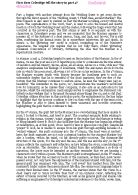How does Coleridge tell the story in part 3 of Rime of the Ancient Mariner
How does Coleridge tell the story in part 3? Úna Richards 26/03/2013
The opening line of part 3 in the first stanza, ‘THERE passed a weary time’, indicates to the reader that the Mariner is still in a state of suffering, continued from part 2. The capitalisation of the word, ‘there’, suggests that nature’s torture is only being directed at those on the ship. Coleridge furthers the idea of nature’s torture in this stanza through his use of death imagery, ‘each throat was parched and glazed each eye.’ The word, ‘glazed’ implies a sort of mental vacancy or vegetation, whilst ‘parched’ denotes that they are completely dried out, not only are they dehydrated but they are dried out in the sense that the Mariner has now completely lost any remnant of hope and faith in nature. The enjambment in the line is used to highlight and emphasise the extent of the dehydration among the ship’s crew. However, by the 5th line, the tone of the stanza has become less sullen, shown through Coleridge’s deviation from the ballad form. The two extra lines mark the sense of hope newly acquired by the ship after they see a ‘something in the sky.’
Both the second and third stanzas return to the traditional ballad form to show the ficklness of the Mariner’s hope. In stanza 2, Coleridge uses nebulous language, ‘shape’ and ‘seemed’, in this stanza in order to maintain the suspense caused by both the reader and the Mariner’s uncertainty about this ‘speck.’ It’s also used to reflect the desperation of the Mariner, as his tone has become more positive despite the potentially dangerous object. The Mariner’s self-assured tone continues in the third stanza, shown through the structural device of punctuation, ‘A speck, a mist, a shape, I wist!’ The exclamation is used in order to show the hopefullness of the Mariner, the internal rhyme used by Coleridge also creates an upbeat tone, as it speeds up the pace of the poem. Coleridge creates a contrast with the quote, ‘[the object] plunged and tacked and veered’, as the Mariner’s own ship is completely still, the contrast implies to the reader that, perhaps, this ‘sprite’ may be of the supernatural realm, as there is no breeze after all.







